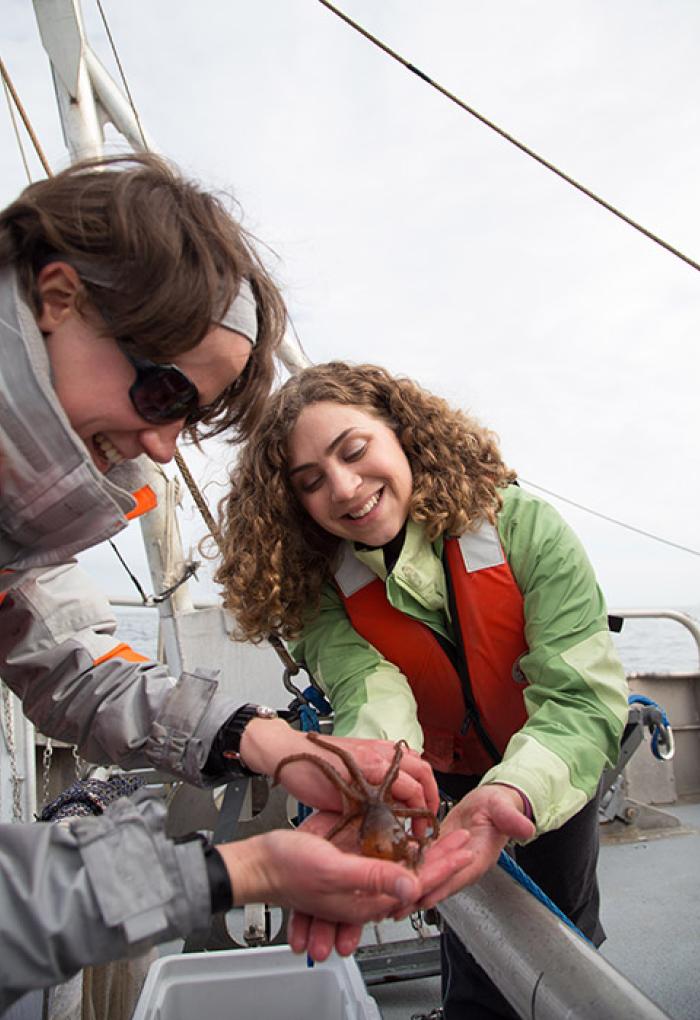This urgency is driving many scientists to step out of the lab and into the public sphere. Hundreds of scientists attended a "stand up for science" rally at the fall meeting of the American Geophysical Union; thousands more participated in the national "March for Science" on Earth Day, April 22, 2017. Some, like evolutionary biologist and University of California professor Michael Eisen, are running for political office. Others, feeling that valuable troves of climate data stored by the government are at risk of being destroyed, are engaged in fervid “data rescue” onto private servers. Skilled advocates like OSU’s Distinguished Professor Jane Lubchenco, who recently won the National Academy of Science’s Public Welfare Award, are trying to figure out the best way for scientists to appeal to a skeptical or scattered public ;in a world of "fake news."
West Coast advocacy for healthy oceans
Scientists are also acting collectively in new ways to make sure that relevant research crosses the desks of policymakers, particularly when it comes to climate change. Integrative Biology professor Francis Chan, for example, is co-chair of a 20-member panel of leading West Coast ocean scientists who presented a comprehensive report last year outlining recommendations to decrease ocean acidification and hypoxia, or extremely low oxygen levels.
The report urges the governments of Oregon, California, Washington and British Columbia to act now to offset and mitigate the effects of global carbon dioxide emissions, which are rapidly changing ocean chemistry along the West Coast.
Chan’s recommendations were grave but hopeful, going beyond just painting a “gloom and doom” picture to offering many ways to remedy ocean acidification, from planting kelp and eel grass, which remove carbon dioxide, to better breeding techniques for shellfish and cleaner resource management.
Global ocean conservation
Marine biologist Jane Lubchenco and her colleague Kirsten Grorud-Colvert are important voices in the international ocean conservation community. Lubchenco, the U.S. State Department’s science envoy on ocean policy issues and former NOAA Administrator, and Grorud-Colvert published a paper in the journal Science. It highlighted the need for greater ocean protection to support fish stocks and to be better stewards of our oceans and the benefits they provide us all.
Scientists coordinating their research internationally can be powerful advocates for global environmental protection and policy. Microbiologist Rebecca Vega Thurber, for example, leads a National Science Foundation (NSF)-funded Global Coral Microbiome Project that seeks to describe and analyze the macrobiotic diversity in coral reefs around the world, coordinating her lab's work with researchers at Australia's Great Barrier Reef and Saudi Arabia's Red Sea coast.
The ultimate goal is to understand how microbial communities can help coral reefs withstand and recover from stress or disease. The research may be critical to international efforts to mitigate the worldwide decline in coral reefs due to overfishing, pollution, and climate change.
Policy-focused research
Policymakers sometimes collaborate with scientists to do specific research. Marine ecologist Sarah Henkel, for example, is often out on the ocean, analyzing field samples to advise policymakers on how human activity and climate change affect marine life. She checks for heavy metals and organic pollutants in coastal marine species exposed to effluent from an industrial outfall pipe in Newport.
Recently, she led a research cruise analyzing sediment grabs of the ocean floor for species habitat suitability maps. The maps will guide the Bureau of Ocean Energy Management in managing effects from offshore energy and mineral exploration on the Outer Continental Shelf.
Close to home: Salmon fisheries
Scientists like microbiologist Jerri Bartholomew are changing policy at the local level. A long-term project in the Klamath River integrates monitoring and research to develop recommendations for fishery management by providing real- time data on parasite densities and their predicted effects on juvenile salmon. When parasite levels and water temperatures exceed set thresholds, this triggers river managers to release a pulse of water from the reservoir to reduce disease risk. Models developed by her team link areas of high disease risk with physical parameters, such as water flows and temperature, and forecast how climate change might alter infection rates in the future.
***Read the rest of this series on how scientists at OSU are tackling global warming: Warm Oceans need Cool Science (introduction) Quantifying Risk Sustaining Resources





